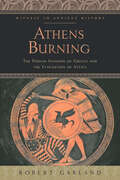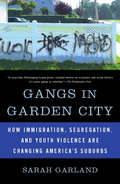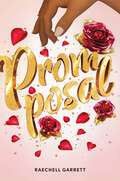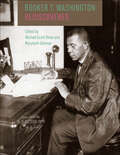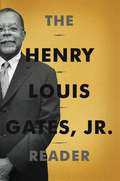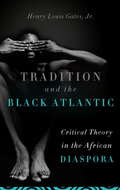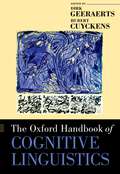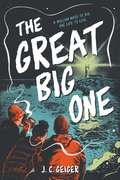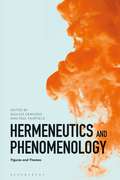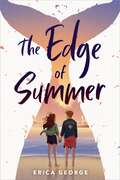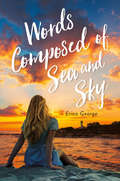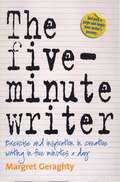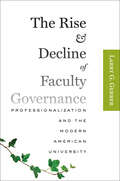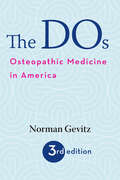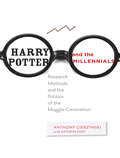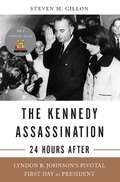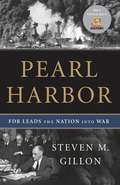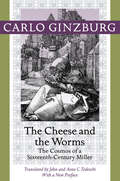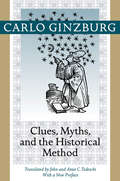- Table View
- List View
Athens Burning: The Persian Invasion of Greece and the Evacuation of Attica (Witness to Ancient History)
by Robert GarlandBetween June 480 and August 479 BC, tens of thousands of Athenians evacuated, following King Xerxes;€™ victory at the Battle of Thermopylae. Abandoning their homes and ancestral tombs in the wake of the invading Persian army, they sought refuge abroad. Women and children were sent to one safe haven, the elderly to another, while all men of military age were conscripted into the fleet. During this difficult year of exile, the city of Athens was set on fire not once, but twice. In Athens Burning, Robert Garland explores the reasons behind the decision to abandon Attica, the peninsular region of Greece that includes Athens, while analyzing the consequences, both material and psychological, of the resulting invasion.Garland introduces readers to the contextual background of the Greco-Persian wars, which include the famous Battle of Marathon. He describes the various stages of the invasion from both the Persian and Greek point of view and explores the siege of the Acropolis, the defeat of the Persians first by the allied Greek navy and later by the army, and, finally, the return of the Athenians to their land.Taking its inspiration from the sufferings of civilians, Athens Burning also works to dispel the image of the Persians as ruthless barbarians. Addressing questions that are largely ignored in other accounts of the conflict, including how the evacuation was organized and what kind of facilities were available to the refugees along the way, Garland demonstrates the relevance of ancient history to the contemporary world. This compelling story is especially resonant in a time when the news is filled with the suffering of nearly 5 million people driven by civil war from their homes in Syria. Aimed at students and scholars of ancient history, this highly accessible book will also fascinate anyone interested in the burgeoning fields of refugee and diaspora studies.
Athens Burning: The Persian Invasion of Greece and the Evacuation of Attica (Witness to Ancient History)
by Robert GarlandBetween June 480 and August 479 BC, tens of thousands of Athenians evacuated, following King Xerxes;€™ victory at the Battle of Thermopylae. Abandoning their homes and ancestral tombs in the wake of the invading Persian army, they sought refuge abroad. Women and children were sent to one safe haven, the elderly to another, while all men of military age were conscripted into the fleet. During this difficult year of exile, the city of Athens was set on fire not once, but twice. In Athens Burning, Robert Garland explores the reasons behind the decision to abandon Attica, the peninsular region of Greece that includes Athens, while analyzing the consequences, both material and psychological, of the resulting invasion.Garland introduces readers to the contextual background of the Greco-Persian wars, which include the famous Battle of Marathon. He describes the various stages of the invasion from both the Persian and Greek point of view and explores the siege of the Acropolis, the defeat of the Persians first by the allied Greek navy and later by the army, and, finally, the return of the Athenians to their land.Taking its inspiration from the sufferings of civilians, Athens Burning also works to dispel the image of the Persians as ruthless barbarians. Addressing questions that are largely ignored in other accounts of the conflict, including how the evacuation was organized and what kind of facilities were available to the refugees along the way, Garland demonstrates the relevance of ancient history to the contemporary world. This compelling story is especially resonant in a time when the news is filled with the suffering of nearly 5 million people driven by civil war from their homes in Syria. Aimed at students and scholars of ancient history, this highly accessible book will also fascinate anyone interested in the burgeoning fields of refugee and diaspora studies.
Gangs in Garden City: How Immigration, Segregation, and Youth Violence are Changing America's Suburbs
by Sarah GarlandFor the past five years, journalist Sarah Garland has followed the lives of current and former gang members living in Hempstead on the border of Garden City, Long Island. Affiliated with Mara Salvatrucha and 18th Street, their troubling personal stories expose the cruel realities of segregation, racial income gaps, and poverty that lie hidden behind suburban white picket fences.As Garland travels from Los Angeles to El Salvador and back to the East Coast, she reveals a disturbing cycle of poverty in which families, fleeing from troubled Central American cities, move into America's suburban backyards, only to find the pattern of violence repeating itself. Brilliantly reported and sensitively told, Gangs in Garden City draws back the veil on a hidden, troubling world.
Promposal
by RaeChell GarrettAn overachiever must decide if risking her heart by working with her former crush turned enemy is worth the reward in this snappy rom-com, perfect for fans of Tweet Cute and The Upside of Falling. High school senior Autumn Reeves has been waitlisted at her dream school. Determined to move to the top of the list, she must find a way to stand out. When a promposal she planned for a friend has half the senior class asking for her help, a brilliant business idea that will look great on her application is born: Promposal Queen. Autumn has no clue how to start a business, so she joins the Young Black Entrepreneurs group and finds herself face-to-face with Mekhi Winston, the boy whose unexpected freshman-year kiss—a kiss that meant everything to her and nothing to him—cost Autumn her best friend. He&’s the only person with the experience to help her, but how can she possibly trust him? With her dreams on the line, Autumn&’s willing to risk it. After all, Mekhi could be a good business partner without being a guy she would ever let near her heart again. But when working with Mekhi jeopardizes her only chance at rekindling a friendship with her ex-best-friend, and secrets long buried threaten to ruin Promposal Queen, another broken heart may be the least of her worries--her entire future is on the line.
Booker T. Washington Rediscovered
by Marybeth Gasman Michael Scott BiezeBooker T. Washington, a founding father of African American education in the United States, has long been studied, revered, and reviled by scholars and students. Born into slavery, freed and raised in the Reconstruction South, and active in educational reform through the late nineteenth and early twentieth centuries, Washington sought to use education to bridge the nation’s racial divide. This volume explores Washington’s life and work through his writings and speeches. Drawing on previously unpublished writings, hard-to-find speeches and essays, and other primary documents from public and private collections, Michael Scott Bieze and Marybeth Gasman provide a balanced and insightful look at this controversial and sometimes misunderstood leader. Their essays follow key themes in Washington’s life—politics, aesthetics, philanthropy, religion, celebrity, race, and education—that show both his range of thought and the evolution of his thinking on topics vital to African Americans at the time. Wherever possible, the book reproduces archival material in its original form, aiding the reader in delving more deeply into the primary sources, while the accompanying introductions and analyses by Bieze and Gasman provide rich context. A companion website contains additional primary source documents and suggested classroom exercises and teaching aids.Innovative and multifaceted, Booker T. Washington Rediscovered provides the opportunity to experience Washington’s work as he intended and examines this turn-of-the-century pioneer in his own right, not merely in juxtaposition with W. E. B. Du Bois and other black leaders.
The Henry Louis Gates, Jr. Reader
by Henry Louis GatesEducator, writer, critic, intellectual, film-maker-Henry Louis Gates, Jr., has been widely praised as being one of America's most prominent and prolific scholars. In what will be an essential volume, The Henry Louis Gates, Jr., Reader collects three decades of writings from his many fields of interest and expertise.From his earliest work of literary-historical excavation in 1982, through his current writings on the history and science of African American genealogy, the essays collected here follow his path as historian, theorist, canon-builder, and cultural critic, revealing a thinker of uncommon breadth whose work is uniformly guided by the drive to uncover and restore a history that has for too long been buried and denied.An invaluable reference, The Henry Louis Gates, Jr., Reader will be a singular reflection of one of our most gifted minds.
Tradition and the Black Atlantic: Critical Theory in the African Diaspora
by Henry Louis Gates Jr.Henry Louis Gates, Jr.'s Tradition and the Black Atlantic is both a vibrant romp down the rabbit hole of cultural studies and an examination of the discipline's roots and role in contemporary thought. In this conversational tour through the halls of theory, Gates leaps from Richard Wright to Spike Lee, from Pat Buchanan to Frantz Fanon, and ultimately to the source of anticolonialist thought: the unlikely figure of Edmund Burke.Throughout Tradition and the Black Atlantic, Gates shows that the culture wars have presented us with a surfeit of either/ors-tradition versus modernity; Eurocentrism versus Afrocentricism. Pointing us away from these facile dichotomies, Gates deftly combines rigorous scholarship with humor, looking back to the roots of cultural studies in order to map out its future course.
The Oxford Handbook of Cognitive Linguistics: Selected Papers From The International Cognitive Linguistics Conference, Amsterdam, 1997 (Oxford Handbooks #177)
by Dirk Geeraerts Hubert CuyckensThe Oxford Handbook of Cognitive Linguistics presents a comprehensive overview of the main theoretical concepts and descriptive/theoretical models of Cognitive Linguistics, and covers its various subfields, theoretical as well as applied. The first twenty chapters give readers the opportunity to acquire a thorough knowledge of the fundamental analytic concepts and descriptive models of Cognitive Linguistics and their background. The book starts with a set of chapters discussing different conceptual phenomena that are recognized as key concepts in Cognitive Linguistics: prototypicality, metaphor, metonymy, embodiment, perspectivization, mental spaces, etc. A second set of chapters deals with Cognitive Grammar, Construction Grammar, and Word Grammar, which, each in their own way, bring together the basic concepts into a particular theory of grammar and a specific model for the description of grammatical phenomena. Special attention is given to the interrelation between Cognitive and Construction Grammar. A third set of chapters compares Cognitive Linguistics with other forms of linguistic research (functional linguistics, autonomous linguistics, and the history of linguistics), thus giving a readers a better grip on the position of Cognitive Linguistics within the landscape of linguistics at large. The remaining chapters apply these basic notions to various more specific linguistic domains, illustrating how Cognitive Linguistics deals with the traditional linguistic subdomains (phonology, morphology, lexicon, syntax, text and discourse), and demonstrating how it handles linguistic variation and change. Finally they consider its importance in the domain of Applied Linguistics, and look at interdisciplinary links with research fields such as philosophy and psychology. With a well-known cast of contributors from around the world, this reference work will be of interest to researchers and advanced students in (cognitive) linguistics, psychology, cognitive science, and anthropology.
The Great Big One
by J. C. GeigerWith natural disasters and nuclear war threatening their small town, two twin brothers find themselves enraptured by mysterious music that could change the course of their lives.Everyone in Clade City knows their days are numbered. The Great Cascadia Earthquake will destroy their hometown and reshape the entire West Coast—if they survive long enough to see it. Nuclear war is increasingly likely. Wildfires. Or another pandemic. To Griff, the daily forecast feels partly cloudy with a chance of apocalyptic horsemen.Griff&’s brother, Leo, and the Lost Coast Preppers claim to be ready. They&’ve got a radio station. Luminous underwater monitors. A sweet bunker, and an unsettling plan for &“disaster-ready rodents.&” But Griff&’s more concerned about what he can do before the end times. He&’d like to play in a band, for one. Hopefully with Charity Simms. Her singing could make the whole world stop.When Griff, Leo, and Charity stumble upon a mysterious late-night broadcast, one song changes everything. It&’s the best band they&’ve ever heard—on a radio signal even the Preppers can&’t trace. They vow to find the music, but aren&’t prepared for where their search will take them. Or for what they&’ll risk, when survival means finding the one thing you cannot live without.
Hermeneutics and Phenomenology: Figures and Themes (Social Imaginaries Ser.)
by Saulius Geniusas Paul FairfieldThe relationship between these two central theoretical and philosophical approaches, which we thought we knew, is more complex and interesting than our standard story might suggest. It is not always clear how hermeneutics-that is, post-Heideggerian hermeneutics as articulated by Hans-Georg Gadamer, Paul Ricoeur, and a large number of thinkers working under their influence-regards the phenomenological tradition, be it in its Husserlian or various post-Husserlian formulations. This volume inquires into this issue both in general, conceptual terms and through specific analyses into questions of ontology and metaphysics, science, language, theology, and imagination. With a substantial editors' introduction, the volume contains 15 chapters, from some of the most significant scholars in this field covering the essential questions about the history, present and future of these two disciplines. The volume will be of interest to any philosopher or student with an interest in developing a sophisticated and nuanced understanding of contemporary hermeneutics and phenomenology.
The Edge of Summer
by Erica GeorgeFans of Sarah Dessen and Morgan Matson will be swept away by this big-hearted novel about one girl navigating first loss and first love during a summer on Cape Cod. Saving the whales has been Coriander Cabot and her best friend Ella&’s dream since elementary school. But when tragedy strikes, Cor is left to complete the list of things they wanted to accomplish before college alone, including a marine biology internship on Cape Cod. Cor's summer of healing and new beginnings turns complicated when she meets Mannix, a local lifeguard who completely takes her breath away. But she knows whatever she has with Mannix might not last, and that her focus should be on rescuing the humpback whales from entanglement. As the tide changes, Cor finds herself distracted and struggling with her priorities. Can she follow her heart and keep her promise to the whales and her best friend?
Words Composed of Sea and Sky
by Erica GeorgeThis modern summer romance set on Cape Cod features two young adult poets divided by centuries. Michaela Dunn, living on present day Cape Cod, dreams of getting into an art school, something her family just doesn't understand. When her stepfather refuses to fund a trip for a poetry workshop, Michaela finds the answer in a local contest searching for a poet to write the dedication plaque for a statue honoring Captain Benjamin Churchill, a whaler who died at sea 100 years ago.She struggles to understand why her town venerates Churchill, an almost mythical figure whose name adorns the school team and various tourist traps. When she discovers the 1862 diary of Leta Townsend, however, she gets a glimpse of Churchill that she didn't quite anticipate. In 1862, Leta Townsend writes poetry under the name Benjamin Churchill, a boy who left for sea to hunt whales. Leta is astonished when Captain Churchill returns after his rumored death. She quickly falls for him. But is she falling for the actual captain or the boy she constructed in her imagination?
The Five-Minute Writer: Exercise and inspiration in creative writing in five minutes a day
by Margret GeraghtySuitable for writers, this title includes chapters that offers a writing-related discussion, followed by a five-minute exercise. Five minutes a day spent on an exercise is one of the most effective methods there is to expand your potential and develop self-discipline.
The Rise and Decline of Faculty Governance: Professionalization and the Modern American University
by Larry G. GerberThe Rise and Decline of Faculty Governance is the first history of shared governance in American higher education. Drawing on archival materials and extensive published sources, Larry G. Gerber shows how the professionalization of college teachers coincided with the rise of the modern university in the late nineteenth century and was the principal justification for granting teachers power in making educational decisions. In the twentieth century, the efforts of these governing faculties were directly responsible for molding American higher education into the finest academic system in the world. In recent decades, however, the growing complexity of "multiversities" and the application of business strategies to manage these institutions threatened the concept of faculty governance. Faculty shifted from being autonomous professionals to being "employees." The casualization of the academic labor market, Gerber argues, threatens to erode the quality of universities. As more faculty become contingent employees, rather than tenured career professionals enjoying both job security and intellectual autonomy, universities become factories in the knowledge economy. In addition to tracing the evolution of faculty decision making, this historical narrative provides readers with an important perspective on contemporary debates about the best way to manage America’s colleges and universities. Gerber also reflects on whether American colleges and universities will be able to retain their position of global preeminence in an increasingly market-driven environment, given that the system of governance that helped make their success possible has been fundamentally altered.
The Rise and Decline of Faculty Governance: Professionalization and the Modern American University
by Larry G. GerberThe Rise and Decline of Faculty Governance is the first history of shared governance in American higher education. Drawing on archival materials and extensive published sources, Larry G. Gerber shows how the professionalization of college teachers coincided with the rise of the modern university in the late nineteenth century and was the principal justification for granting teachers power in making educational decisions. In the twentieth century, the efforts of these governing faculties were directly responsible for molding American higher education into the finest academic system in the world. In recent decades, however, the growing complexity of "multiversities" and the application of business strategies to manage these institutions threatened the concept of faculty governance. Faculty shifted from being autonomous professionals to being "employees." The casualization of the academic labor market, Gerber argues, threatens to erode the quality of universities. As more faculty become contingent employees, rather than tenured career professionals enjoying both job security and intellectual autonomy, universities become factories in the knowledge economy. In addition to tracing the evolution of faculty decision making, this historical narrative provides readers with an important perspective on contemporary debates about the best way to manage America’s colleges and universities. Gerber also reflects on whether American colleges and universities will be able to retain their position of global preeminence in an increasingly market-driven environment, given that the system of governance that helped make their success possible has been fundamentally altered.
The DOs: Osteopathic Medicine in America
by Norman GevitzOvercoming suspicion, ridicule, and outright opposition from the American Medical Association, the osteopathic medical profession today serves the health needs of more than thirty million Americans. Osteopathic medicine is now the fastest-growing segment of the US physician and surgeon population. In The DOs, historian Norman Gevitz chronicles the development of this controversial medical movement from its nineteenth-century origins in the American Midwest to the present day. He describes the philosophy and practice of osteopathy, as well as the impact of osteopathic medicine on health care.In print continuously since 1982, The DOs has now been thoroughly updated and expanded. From the theories underlying the use of spinal manipulation developed by osteopathy's founder, Andrew Taylor Still, Gevitz traces the movement's early success, despite attacks from the orthodox medical community. He also recounts the efforts of osteopathic medical colleges to achieve parity with institutions granting MD degrees and looks at the continuing effort by osteopathic physicians and surgeons to achieve greater recognition and visibility.Bringing additional light to the philosophical origins and practices of the osteopathic movement, as well as the historic debates about which degree to offer its graduates, this volume ;€¢ chronicles the challenges the profession has faced in the early decades of the twenty-first century ;€¢ addresses recent challenges to the osteopathic medical profession;€¢ explores efforts at preserving osteopathy's autonomy and distinctiveness;€¢ offers a new perspective on the future of osteopathic medicine Based on an extensive examination and evaluation of primary sources, as well as countless interviews with individuals both inside and outside osteopathic medicine, The DOs is the definitive history of the osteopathic medical profession.
The DOs: Osteopathic Medicine in America
by Norman GevitzOvercoming suspicion, ridicule, and outright opposition from the American Medical Association, the osteopathic medical profession today serves the health needs of more than thirty million Americans. Osteopathic medicine is now the fastest-growing segment of the US physician and surgeon population. In The DOs, historian Norman Gevitz chronicles the development of this controversial medical movement from its nineteenth-century origins in the American Midwest to the present day. He describes the philosophy and practice of osteopathy, as well as the impact of osteopathic medicine on health care.In print continuously since 1982, The DOs has now been thoroughly updated and expanded. From the theories underlying the use of spinal manipulation developed by osteopathy's founder, Andrew Taylor Still, Gevitz traces the movement's early success, despite attacks from the orthodox medical community. He also recounts the efforts of osteopathic medical colleges to achieve parity with institutions granting MD degrees and looks at the continuing effort by osteopathic physicians and surgeons to achieve greater recognition and visibility.Bringing additional light to the philosophical origins and practices of the osteopathic movement, as well as the historic debates about which degree to offer its graduates, this volume ;€¢ chronicles the challenges the profession has faced in the early decades of the twenty-first century ;€¢ addresses recent challenges to the osteopathic medical profession;€¢ explores efforts at preserving osteopathy's autonomy and distinctiveness;€¢ offers a new perspective on the future of osteopathic medicine Based on an extensive examination and evaluation of primary sources, as well as countless interviews with individuals both inside and outside osteopathic medicine, The DOs is the definitive history of the osteopathic medical profession.
Harry Potter and the Millennials: Research Methods and the Politics of the Muggle Generation
by Anthony GierzynskiWithout a doubt the Harry Potter series has had a powerful effect on the Millennial Generation. Millions of children grew up immersed in the world of the boy wizard—reading the books, dressing up in costume to attend midnight book release parties, watching the movies, and even creating and competing in Quidditch tournaments. Beyond what we know of the popularity of the series, however, nothing has been published on the question of the Harry Potter effect on the politics of its young readers—now voting adults. Looking to engage his students in exploring the connections between political opinion and popular culture, Anthony Gierzynski conducted a national survey of more than 1,100 college students and examined these connections as well as Millennial politics. Harry Potter and the Millennials tells the fascinating story of how the team designed the study and gathered results, explains what conclusions can and cannot be drawn, and reveals the challenges social scientists face in studying political science, sociology, and mass communication. Specifically, the evidence indicates that Harry Potter fans are more open to diversity and are more politically tolerant than nonfans; fans are also less authoritarian, less likely to support the use of deadly force or torture, more politically active, and more likely to have had a negative view of the Bush administration. Furthermore, these differences do not disappear when controlling for other important predictors of these perspectives, lending support to the argument that the series indeed had an independent effect on its audience. In this clear and cogent account, Gierzynski demonstrates how social scientists develop and design research questions and studies. An appendix of questions and resulting data, including graphs and diagrams, will appeal especially to instructors seeking to explain the nuances of political socialization. Gierzynski’s captivating analysis of media’s impact on political views, combined with the enjoyable Potter story details, makes for an irresistible project that social scientists can use to work a little magic in their classrooms.
Harry Potter and the Millennials: Research Methods and the Politics of the Muggle Generation
by Anthony GierzynskiWithout a doubt the Harry Potter series has had a powerful effect on the Millennial Generation. Millions of children grew up immersed in the world of the boy wizard—reading the books, dressing up in costume to attend midnight book release parties, watching the movies, and even creating and competing in Quidditch tournaments. Beyond what we know of the popularity of the series, however, nothing has been published on the question of the Harry Potter effect on the politics of its young readers—now voting adults. Looking to engage his students in exploring the connections between political opinion and popular culture, Anthony Gierzynski conducted a national survey of more than 1,100 college students and examined these connections as well as Millennial politics. Harry Potter and the Millennials tells the fascinating story of how the team designed the study and gathered results, explains what conclusions can and cannot be drawn, and reveals the challenges social scientists face in studying political science, sociology, and mass communication. Specifically, the evidence indicates that Harry Potter fans are more open to diversity and are more politically tolerant than nonfans; fans are also less authoritarian, less likely to support the use of deadly force or torture, more politically active, and more likely to have had a negative view of the Bush administration. Furthermore, these differences do not disappear when controlling for other important predictors of these perspectives, lending support to the argument that the series indeed had an independent effect on its audience. In this clear and cogent account, Gierzynski demonstrates how social scientists develop and design research questions and studies. An appendix of questions and resulting data, including graphs and diagrams, will appeal especially to instructors seeking to explain the nuances of political socialization. Gierzynski’s captivating analysis of media’s impact on political views, combined with the enjoyable Potter story details, makes for an irresistible project that social scientists can use to work a little magic in their classrooms.
The Kennedy Assassination--24 Hours After: Lyndon B. Johnson's Pivotal First Day as President
by Steven M. GillonRiding in an open-topped convertible through Dallas on November 22, 1963, Lyndon B. Johnson heard a sudden explosive sound at 12:30 PM. The Secret Service sped him away to safety, but not until 1:20 PM did he learn that John F. Kennedy had been assassinated. Sworn in next to a bloodstained Jackie Kennedy at 2:40 PM, Johnson worked feverishly until 3:00 in the morning, agonizing about the future of both his nation and his party. Unbeknownst to him, his actions had already determined the tragic outcome of his presidency.In November 22, 1963, historian Steven Gillon tells the story of how Johnson consolidated power in the twenty-four hours following the assassination. Based on scrupulous research and new archival sources, this gripping narrative sheds new and surprising light on one of the most written-about events of the twentieth century.
Pearl Harbor: FDR Leads the Nation Into War (Playaway Adult Nonfiction Ser.)
by Steven M. GillonFranklin D. Roosevelt famously called December 7, 1941, "a date which will live in infamy.” History would prove him correct; the events of that day-when the Japanese bombed Pearl Harbor-ended the Great Depression, changed the course of FDR's presidency, and swept America into World War II. In Pearl Harbor, acclaimed historian Steven M. Gillon provides a vivid, minute-by-minute account of Roosevelt's skillful leadership in the wake of the most devastating military assault in American history. FDR proved both decisive and deceptive, inspiring the nation while keeping the real facts of the attack a secret from congressional leaders and the public.Pearl Harbor explores the anxious and emotional events surrounding the attack on Pearl Harbor, showing how the president and the American public responded in the pivotal twenty-four hours that followed, a period in which America burst from precarious peace into total war.
The Cheese and the Worms: The Cosmos of a Sixteenth-Century Miller
by Carlo GinzburgThe Cheese and the Worms is an incisive study of popular culture in the sixteenth century as seen through the eyes of one man, the miller known as Menocchio, who was accused of heresy during the Inquisition and sentenced to death. Carlo Ginzburg uses the trial records to illustrate the religious and social conflicts of the society Menocchio lived in. For a common miller, Menocchio was surprisingly literate. In his trial testimony he made references to more than a dozen books, including the Bible, Boccaccio's Decameron, Mandeville's Travels, and a "mysterious" book that may have been the Koran. And what he read he recast in terms familiar to him, as in his own version of the creation: "All was chaos, that is earth, air, water, and fire were mixed together; and of that bulk a mass formed—just as cheese is made out of milk—and worms appeared in it, and these were the angels."Ginzburg’s influential book has been widely regarded as an early example of the analytic, case-oriented approach known as microhistory. In a thoughtful new preface, Ginzburg offers his own corollary to Menocchio’s story as he considers the discrepancy between the intentions of the writer and what gets written. The Italian miller’s story and Ginzburg’s work continue to resonate with modern readers because they focus on how oral and written culture are inextricably linked. Menocchio’s 500-year-old challenge to authority remains evocative and vital today.
The Cheese and the Worms: The Cosmos of a Sixteenth-Century Miller
by Carlo GinzburgThe Cheese and the Worms is an incisive study of popular culture in the sixteenth century as seen through the eyes of one man, the miller known as Menocchio, who was accused of heresy during the Inquisition and sentenced to death. Carlo Ginzburg uses the trial records to illustrate the religious and social conflicts of the society Menocchio lived in. For a common miller, Menocchio was surprisingly literate. In his trial testimony he made references to more than a dozen books, including the Bible, Boccaccio's Decameron, Mandeville's Travels, and a "mysterious" book that may have been the Koran. And what he read he recast in terms familiar to him, as in his own version of the creation: "All was chaos, that is earth, air, water, and fire were mixed together; and of that bulk a mass formedâ€�just as cheese is made out of milkâ€�and worms appeared in it, and these were the angels."Ginzburg’s influential book has been widely regarded as an early example of the analytic, case-oriented approach known as microhistory. In a thoughtful new preface, Ginzburg offers his own corollary to Menocchio’s story as he considers the discrepancy between the intentions of the writer and what gets written. The Italian miller’s story and Ginzburg’s work continue to resonate with modern readers because they focus on how oral and written culture are inextricably linked. Menocchio’s 500-year-old challenge to authority remains evocative and vital today.
Clues, Myths, and the Historical Method
by Carlo GinzburgMore than twenty years after Clues, Myths, and the Historical Method was first published in English, this extraordinary collection remains a classic. The book brings together essays about Renaissance witchcraft, National Socialism, sixteenth-century Italian painting, Freud’s wolf-man, and other topics. In the influential centerpiece of the volume Carlo Ginzburg places historical knowledge in a long tradition of cognitive practices and shows how a research strategy based on reading clues and traces embedded in the historical record reveals otherwise hidden information. Acknowledging his debt to art history, psychoanalysis, comparative religion, and anthropology, Ginzburg challenges us to retrieve cultural and social dimensions beyond disciplinary boundaries.In his new preface, Ginzburg reflects on how easily we miss the context in which we read, write, and live. Only hindsight allows some understanding. He examines his own path in research during the 1970s and its relationship to the times, especially the political scenes of Italy and Germany. Was he influenced by the environment, he asks himself, and if so, how? Ginzburg uses his own experience to examine the elusive and constantly evolving nature of history and historical research.
Clues, Myths, and the Historical Method
by Carlo GinzburgMore than twenty years after Clues, Myths, and the Historical Method was first published in English, this extraordinary collection remains a classic. The book brings together essays about Renaissance witchcraft, National Socialism, sixteenth-century Italian painting, Freud’s wolf-man, and other topics. In the influential centerpiece of the volume Carlo Ginzburg places historical knowledge in a long tradition of cognitive practices and shows how a research strategy based on reading clues and traces embedded in the historical record reveals otherwise hidden information. Acknowledging his debt to art history, psychoanalysis, comparative religion, and anthropology, Ginzburg challenges us to retrieve cultural and social dimensions beyond disciplinary boundaries.In his new preface, Ginzburg reflects on how easily we miss the context in which we read, write, and live. Only hindsight allows some understanding. He examines his own path in research during the 1970s and its relationship to the times, especially the political scenes of Italy and Germany. Was he influenced by the environment, he asks himself, and if so, how? Ginzburg uses his own experience to examine the elusive and constantly evolving nature of history and historical research.
